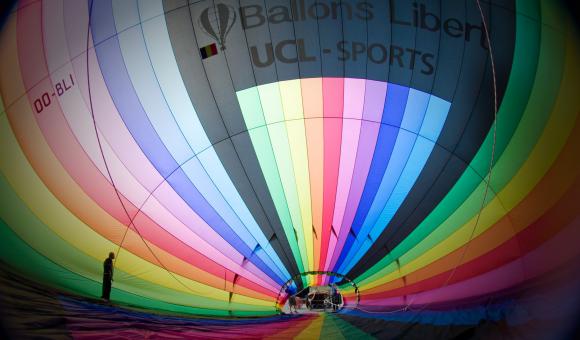
Our craftspeople: unseen Savoir Faire! Patrick Libert May 2017
For some years now, I have been infatuated with beautiful and rare creations. That's because our regions are overflowing with unseen talent, which often has a worldwide reputation. They are there, discreetly set up in their workshops: our craftspeople creating artistic wonders which will dazzle connoisseurs. My aim is to document them all. This fundamentally photographic work gave rise to a website entirely devoted to exceptional handcrafted work.
My last article presented Patrick Libert, a designer and manufacturer of hot-air balloons. Find the full article and the extra images at my site www.lesmiroirsdelombre.com
Patrice Niset - May 2017.
What do a cement mixer and a hot-air balloon have in common? The perfect balance of volume and ideal contours, of course! Patrick Libert is clearly unique. He has devoted his life to hot-air balloons, and cement mixers are his passion, since he collects them. It was important that there was a connection between the two. One thing is certain, Patrick is the one and only manufacturer of hot-air balloons in Belgium, and as such, he is the only approved constructor of aircraft in the Kingdom, no less.
Delving into the world of Patrick Libert involves following the construction of a balloon in the workshop, but also going out into the open to launch these wonderful creations which are lighter than air. Report.
LMdO: Patrick, can you tell me about the origins of your company?
Patrick Libert: It all started when I was 9 years old. In 1970, hot-air balloons got a new lease of life after having been sat on the shelves for 180 years. The first hot-air flights were particularly dangerous because the envelope was made of paper and the heat source came from burnt straw. On landing, the balloon caught fire, with all the problems that that can entail. It was not until the 1960s that the conditions were such that it was possible to fly with hot-air in complete safety: non-flammable and light fabrics, and heating gas in light and reliable aluminium containers. It was the Americans who updated the hot-air balloon during this period, in particular following research carried out into parachutes which made it possible for the Apollo spacecraft to land in the sea in complete safety. The English followed suit and came to fly in Walloon Brabant one sunny day in April 1970 with this extraordinarily modern machine, which was unknown here. Walloon Brabant was already the ideal spot in Belgium for flying. That was handy, because we lived there. When I saw this mass appear above my head, my life was changed forever. I convinced my father to follow the aircraft in the car until it landed, and my love for hot-air balloons was ignited that day .... just by chance it seems.
LMdO: At the tender age of 9, you recognised its potential?
PL: I was convinced straightaway that this contraption would not be a fad, that there would be a future for this means of flying, unlike the initial balloons of the Montgolfier brothers which were tried out for the first time in 1783. Once hooked, I convinced my parents to closely follow the small fledgling community of Belgian hot-air balloon pilots. For months, we helped out with the flights, which were rare at the time. We assisted and observed. We tried to understand. Sometimes, we flew. One thing led to another, my mother was a seamstress and she started to make repairs to damaged balloons. She quickly became an indispensable reference, to the extent that she knew all the defects of balloons made in Europe. To end up designing a balloon seemed logical, after this experience. It was all still to be invented.
LMdO: And you improvised as an aeronautical engineer?
PL: My parents initially wanted me to do "serious" studies, to secure my future in case the balloon turned out to be a false dawn. I never actually practised the profession for which I trained, occupational therapy. But to answer your question, it was my father, who was an industrial designer for Henricot, a steel plant, who designed and developed the Libert balloons. At the time, everything was simple, there was little or no regulation. We could therefore venture off into the discipline without too many constraints, kind of with our intuition. Nonetheless, my father's calculations needed to be exact and reliable to obtain an optimal heat balance of the envelope, the sine qua non of flying a balloon in complete safety. It would be completely impossible to start up an aeronautical project today on such light foundations, but we did it. That's how it was back then. So we actually started by constructing inflatable structures for advertising, and remote-controlled balloons of +/- 50m3 in the middle of a complete legal vacuum. The balloons followed as a logical progression.
LMdO: Have times changed?
PL: Like night and day. From being an intimate sport, hot-air balloon flying has become a business with +/- 300 balloons registered in Belgium, of which half are operational. That's huge in relation to the size of Belgium and narrowness of flying zones. Regulations have become incredibly complex. Accreditations are issued at the European level, to the extent that at the start of the 2000s, no-one predicted our demise, starting with the Belgium aeronautical administration. When I obtained European certificates, they came to the workshop for the photo, although there was really no reason for them to be there. In general, flying has become more difficult, more restrictive. Urban density creates more and more problems for us. Wind turbines and high-voltage cables are spreading like wildfire. In 2017, a pilot needs to be very vigilant.
LMdO: Would you say that the golden years of hot-air flight are behind us?
PL: It's becoming difficult to make it stack up. Advertising sponsorship has long been the royal road for flying more cheaply. But the budgets are decreasing as gas, fabrics and aeronautical taxes are increasing. The decline is slow and gentle, but noticeable. For example, American companies, pioneers in the discipline, are closing one after the other. There are 7 constructors remaining in Europe, who just about do OK. The major manufacturers live off exports to Asia or Africa, where open spaces and favourable legislation still prevail. Ballons Libert remains in its niche: balloons on a human scale for pleasant and comfortable flights, and of course in complete safety. In general, you choose Libert to buy the balloon of your dreams, rather than a balloon for promotional purposes, or a balloon to make a profit. There is a certain form of tradition in our savoir-faire. To date, I have built more than 70 balloons under my own name and my brand. I've lost count of the refurbishments which are made to the balloon covering when the life span of the fabric has been exceeded. In any event, I refuse to build huge balloons designed to carry groups of up to 20 people. If you ask me, it's pure madness.
LMdO: You are a privileged observer. Do you notice climate change?
PL: Absolutely. The area of atmospheric stability is becoming visibly limited. In the future, it will be necessary to take off earlier and earlier in the day in relation to sunrise, or later and later in relation to sunset, at times when potential sponsors will not be seen, or hardly at all. That makes the business model even more complex. In Spain, for example, it is cold during the night. In the morning, the air is stable for an hour or two. Then the temperature shoots up. This phenomenon combined with unbridled urbanisation encourages the formation of storms, or at the very least instability, which makes flying impossible. Hot-air balloon flying in Spain is therefore doomed. A few years ago, I flew around 20 times in May. Last year, I flew 10 times. That is telling.
LMdO: You spoke about vigilance. You fly by sight, without GPS and without transponder, that's not very modern is it?
PL: Most new pilots equip their balloons with these technological aids. The result is that they spend their flight with their eyes glued to their screens. In my view, they're missing out on the most important thing, namely the random nature of a flight and the fact that time freezes. What's more, it is generally the best-equipped pilots who end up in high-voltage lines, occupied as they are trying to check 1001 parameters, whereas the most important thing is to feel at one with the machine and your environment. Fortunately, accidents remain rare, but I am really an old-school piloting expert, if I may say so. However, the real danger comes from abroad, where decommissioned European balloons end their days in complete legal, legislative and technical chaos. Accidents are frequent, and are often fatal. It is since balloons have become large transporters that they have killed people. At Libert, flights are limited to 4 people, 5 at the very most. And believe me, in the basket, everyone has an unbelievable experience. In my view, taking 20 passengers in a basket is folly.
LMdO: What do you like about your profession?
PL: When I take off, I leave behind the hustle and bustle of my contemporaries. In a balloon, you still have the feeling that you can control things which in principle are indomitable. It's also a circle of friends who are brought together and find motivation in often fanciful projects. A pilot is nothing without his take-off and recovery team. These passionate people, who are confined to rather less glamorous roles than flying, have to put up with last-minute cancellations. For example when I consider that the security conditions are not met and I cancel a flight at the last second when the balloon is already upright, ready to take off. It also sometimes happens that I have to land the balloon in areas which are not particularly easy to access to recover it. Everyone at Libert can remember a landing we did in a small garden surrounded by walls, and we had to carry all the equipment, basket included, over the walls. On days like those, you are reminded that without these people, you are nothing as a pilot.
Additional photographic contributions: Dominique Pire
A Libert hot-air balloon in figures:
- The Libert workshops take two months on average to produce a new hot-air balloon.
- Life span of an envelope: 500 flying hours. In effect, the fabric wears out and there are strict controls.
- Volumes of the envelopes made at Libert: between 2200 & 3000 m3.
- Number of passengers: 5 maximum
- Traditional baskets in woven wickerwork.
- 12 km of stitching on average for a 2500 m3 balloon
- Price: from 30,000 euros





